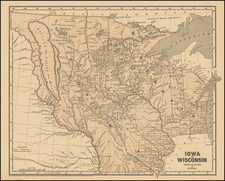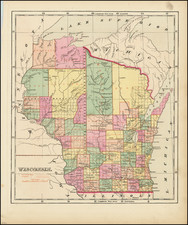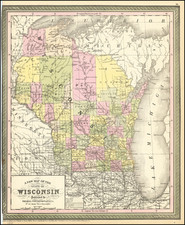Rare map of the City of Milwaukee, published by the city to illustrate a report of the City Engineer.
The map shows the progress of public works up to the end of 1897, showing sewers, intercepting sewers, manholes, block numbers, streets, railroads, parks, cemeteries, and Lake Michigan.
The right margin reads: "Total length of sewer 31.298 Miles," with a list below identifying the various lines with greater detail.
Below mileage data is an explanation noting:
- Pipe Sewers (red)
- Brick Sewers (blue)
- Intercepting Sewers and Milwaukee Flushing Tunnel (Green)
- Manholes (red circles)
Milwaukee Sewer System
When Milwaukee became a city in 1846, wild rice beds still flourished at the mouths of the Kinnickinnic, Menomonee and Milwaukee Rivers. Wild rice, however, is sensitive to water pollution. As Milwaukee grew as a harbor, manufacturing center, and residential hub, pollution increased. Soon, the wild rice was gone.
The City of Milwaukee began construction of a public sewer system in the 1880s to carry wastewater to the surrounding rivers and to Lake Michigan. These sewers carried sewage, untreated, and stormwater directly to the rivers and Lake Michigan. These first sewers were “combined” sewers because sanitary and industrial waste were not separated from stormwater. Everything poured right into the rivers.
This design was insufficient for numerous reasons: the population of the area was too great, the waters smelled horrible, and there were fears of disease and contaminated drinking water.
In 1888, the government took the approach of diluting the polluted waters with clean water from Lake Michigan. They built a flushing tunnel (illustrated here in green), which pumped water from Lake Michigan into the stagnant Milwaukee River, just below the North Avenue Dam. The present map illustrates the progress in creating the city's solution to the problem in its eighth year, following the city's publication of an 1889 report entitled, “Report of the Commission of Engineers on the Collection and Final Disposal of the Sewage and on the Water Supply of the City of Milwaukee.”
In 1907, a similar pumping tunnel was constructed in the Kinnickinnic River.
Rarity
We note an example dated December 1887 in the collections of Columbia University and Carnegie Mellon University, and a copy dated December 1894 in the collection of the Milwaukee Historical Society









![[ The Old Northwest Territory ] Il Paese De Selvaggi Outagamiani, Mascoutensi Illinesi E parte Delle VI Naxioni](https://storage.googleapis.com/raremaps/img/small/75927.jpg)



![[Wisconsin Dells] Map of Kilbourn City Wisconsin](https://storage.googleapis.com/raremaps/img/small/91852.jpg)
